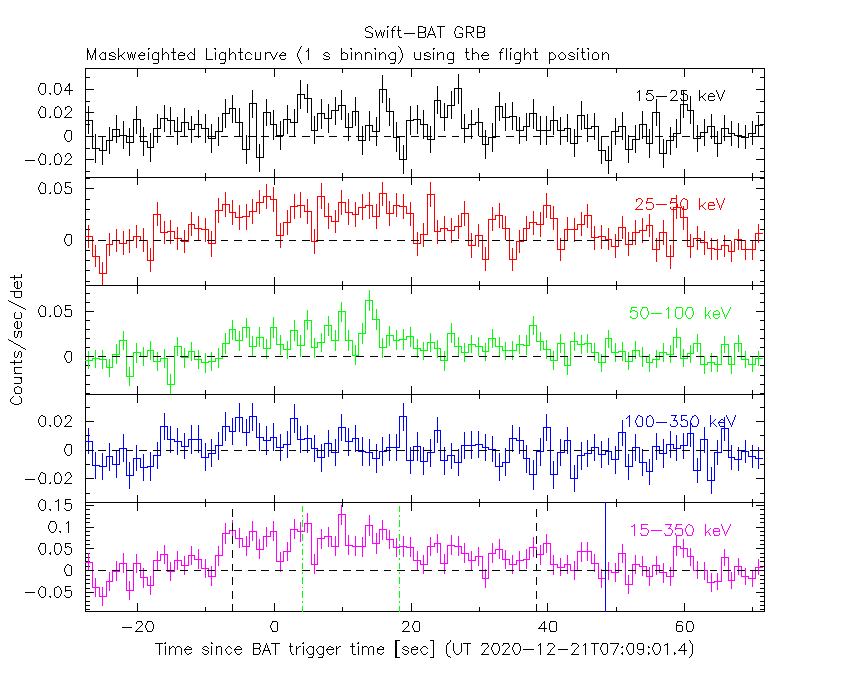
K.L. Page (U. Leicester), A.P. Beardmore (U. Leicester) and A.A. Breeveld (UCL-MSSL) for the Swift team
At 07:09:01 UT, the Swift Burst Alert Telescope (BAT) triggered and located GRB 201221A (trigger=1013852) (Page et al. GCN Circ. 29096). Swift slewed immediately to the burst. At the time of the trigger, the initial BAT position was 49° from the Sun (3.7 hours West) and 116° from the 43%-illuminated Moon. Table 1 contains the best reported positions from Swift, and the latest XRT position can be viewed at http://www.swift.ac.uk/xrt_positions.
Malesani et al. (GCN Circ. 29100) reported the position from VLT for the optical afterglow of this GRB. Malesani et al. (GCN Circ. 29100) determined a redshift of 5.70 from VLT. Table 2 is a summary of GCN Circulars about this GRB from observatories other than Swift.
Standard analysis products for this burst are available at https://gcn.gsfc.nasa.gov/swift_gnd_ana.html.
As reported by Barthelmy et al. (GCN Circ. 29116),
the BAT ground-calculated position is RA, Dec = 214.488, -45.406 deg which is RA(J2000) = 1
The mask-weighted light curve (Figure 1) shows a weak pulse that starts at ~T-7 s and ends at ~T+40 s.
The time-averaged spectrum from T-7.63 to T+41.72 s is best fit by a simple power-law model.
The power law index of the time-averaged spectrum is 1.40 ± 0.15.
The fluence in the 15-150 keV band is 1.9 ± 0.2 x 1
The results of the batgrbproduct analysis are available at https://gcn.gsfc.nasa.gov/notices_s/1013852/BA/.
Analysis of the initial XRT data was reported by Beardmore et al. (GCN Circ. 29108). We have analysed 19 ks of XRT data for GRB 201221A, from 143 s to 241.2 ks after the BAT trigger. The data comprise 320 s in Windowed Timing (WT) mode with the remainder in Photon Counting (PC) mode. The enhanced XRT position for this burst was given by Beardmore et al. (GCN Circ. 29097).
The light curve (Figure 2) can be modelled with an initial power-law decay with an index of α=0.59 ± 0.07, followed by a break at T+10.6 ks to an α of 1.75 (+0.24, -0.21).
A spectrum formed from the PC mode data can be fitted with an absorbed power-law with a photon spectral index of 1.45 (+0.16, -0.15). The best-fitting absorption column is 7.3 (+8.0, -6.2) x 1
A summary of the PC-mode spectrum is thus:
Galactic foreground: 9.3 x 1
Intrinsic column: 7.3 (+8.0, -6.2) x 1
Photon index: 1.45 (+0.16, -0.15)
The results of the XRT team automatic analysis are available at http://www.swift.ac.uk/xrt_products/01013852.
The Swift/UVOT began settled observations of the field of GRB 201221A 141 s after the BAT trigger
(Breeveld and Page GCN Circ. 29109).
No optical afterglow consistent with the optical position (Malesani et al. GCN Circ. 29100) is detected in the initial UVOT exposures.
Table 3 gives preliminary
magnitudes using the UVOT photometric system
(Breeveld et al. 2011, AIP Conf. Proc., 1358, 373).
No correction has been made for the expected extinction in the Milky Way
corresponding to a reddening of

Figure 1. The BAT
mask-weighted light curve in the four individual and total
energy bands. The units are counts

Figure 2. The XRT light curve.
Any data from a crosshatched region are not included in the fit.
| RA (J2000) | Dec (J2000) | Error | Note | Reference |
|---|---|---|---|---|
| 1 |
-45°24'58.1" | 1.5" | XRT-final | UKSSDC |
| 1 |
-45°24'58.3" | 1.5" | XRT-enhanced | Beardmore et al. GCN Circ. 29105 |
| 1 |
-45°24'20.8" | 1.6' | BAT-refined | Barthelmy et al. GCN Circ. 29116 |
| Band | Authors | GCN Circ. | Subject | Observatory | Notes |
|---|---|---|---|---|---|
| Optical | Lipunov et al. | 29098 | Swift GRB 201221A: Global MASTER-Net observations report |
MASTER | |
| Optical | Jelinek et al. | 29099 | FRAM-Auger optical limit | FRAM | upper limits |
| Optical | Malesani et al. | 29100 | VLT/X-shooter afterglow discovery and spectroscopic redshift z = 5.7 |
VLT | redshift |
| Optical | D'Avanzo et al. | 29149 | REM early-time afterglow detection | REM | detection |
| Gamma-ray | Veres | 29110 | Fermi GBM Sub-Threshold Detection | Fermi GBM | Fluence=3.30±0.27x1 |
| Gamma-ray | Veres | 29111 | correction to GCN Circ. 29110 - Fermi GBM Sub-Threshold Detection |
Fermi GBM | |
| Gamma-ray | Frederiks et al. | 29150 | Konus-Wind detection and joint Konus-Wind + Swift-BAT spectral analysis |
Konus-Wind |
| Filter | Exp(s) | Mag | ||
|---|---|---|---|---|
| whit |
141 | 291 | 147 | >20.0 |
| 300 | 549 | 246 | >19.1 | |
| white | 141 | 951 | 257 | >20.2 |
| v | 629 | 4762 | 236 | >18.8 |
| b | 555 | 748 | 39 | >18.3 |
| u | 300 | 5271 | 357 | >19.5 |
| w1 | 679 | 5172 | 236 | >19.4 |
| m2 | 654 | 4967 | 236 | >19.2 |
| w2 | 605 | 4557 | 235 | >19.4 |
Table 3. UVOT observations reported by Breeveld and Page (GCN Circ. 29109). The start and stop times of the exposures are given in seconds since the BAT trigger. The preliminary 3-σ upper limits are given. No correction has been made for extinction in the Milky Way.
December 24, 2020